No edit summary |
No edit summary |
||
| Line 162: | Line 162: | ||
===The Scintillating Legions=== |
===The Scintillating Legions=== |
||
| − | [[File:TzeentchMark.png|thumb|250px|The Mark of Tzeentch]] |
+ | [[File:TzeentchMark.png|thumb|250px|The [[Mark of Tzeentch]]]] |
The air fills with kaleidoscopic bursts of magical energy as the convocations of the Great Conspirator materialise for battle. To mortal eyes, the different [[daemonic]] legions of Tzeentch are impossible to distinguish, each one as bizarre as the next, yet there is method within the madness -- although none save the Architect of Fate himself could truly comprehend it. |
The air fills with kaleidoscopic bursts of magical energy as the convocations of the Great Conspirator materialise for battle. To mortal eyes, the different [[daemonic]] legions of Tzeentch are impossible to distinguish, each one as bizarre as the next, yet there is method within the madness -- although none save the Architect of Fate himself could truly comprehend it. |
||
Revision as of 06:12, 24 January 2018
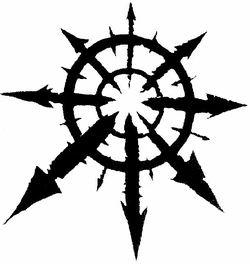
The Star of Chaos
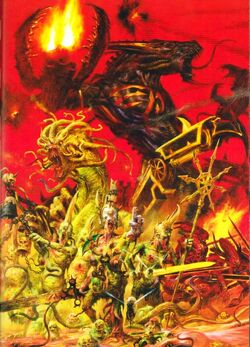
The Daemons of Chaos
A Daemon, also known as a Neverborn amongst the Forces of Chaos, is an intelligent and usually malevolent entity of the Warp that is a living embodiment of Chaos. Daemons are collectively the greatest servants of the Chaos Gods and of Chaos itself as a universal force. They are created at the whim of one of the four major Chaos Gods from a fraction of the god's own power within the Immaterium and act as an extension of his will. A daemon's appearance and intrinsic character reflect the god's own nature. These daemons may be reabsorbed into the god's own psychic signature in the Warp at his whim.
The Chaos Gods are not alone in Warpspace. They have created servants from their own essences -- the creatures that mortals have named daemons based on their ancient legends and religious mythologies -- who are not so closely bound to the Warp. Daemons are entities of a somewhat different nature to their masters, and are the most numerous of the creatures to be found in the Empyrean. A daemon is "born" when a Chaos God expends a portion of its own power to create a separate being. This psychic power binds a collection of senses, thoughts and purposes together, creating a personality and consciousness that can move within the Warp. The Chaos God can reclaim the independence it has given to its daemon children at any time, thus ensuring their loyalty. It is only though the loss of this power that a daemon can truly be destroyed, its mind dissolving into the whirls and currents of Warpspace.
As minions of the Chaos Gods, most daemons lack self-will, at least as humanity understands it. Instead, they serve only to spread the aims of their masters. For example, a daemon of Khorne seeks only battle, and wages war upon other daemons with the same fervour as it does upon mortals. Daemons seemingly spend much of their existence in conflict with other daemons, as each of the Chaos Gods seeks to expand its power and influence as part of the Great Game. It is only when the mortal world is involved that daemons tend to band together and cooperate, and even then, such alliances are short-lived, as each of the four Chaos lords seeks to prevent the other from gaining any sort of advantage.
Daemons have no physical presence within the Warp. The Realm of Chaos is anathema to the laws of physics and the starships that navigate its depths do so by taking a skin or bubble of "reality" with them when they enter using their Warp-Drive. Instead of possessing a true physical form, daemons project a form conjured from raw psychic energy that is essentially a lesser interpretation of their master's fundamental nature. Hence, the bizarre and inhuman appearances projected by daemons indicate their presence, status and allegiance to a Chaos God.
Though it may appear to be made of normal matter when it materialises in realspace, a daemon's form is no more physical than it is in the Realm of Chaos. In fact, they are beings of pure Warp energy given shape and depth. When manifested in the material universe, daemons have particular invulnerabilities and weaknesses, as well as many strange powers derived from their Warp-born nature as psychic beings. Slaying a daemon's physical projection does not kill it, but only severs its presence in reality; its true essence in the Warp remains unharmed.
As creatures of pure emotion and psychic energy that are native to the twisted mirror dimension of the Empyrean, daemons cannot survive for long in the cold reality of the material universe. They need some manner of focal point, some channel through which they can transfer their uncanny power from the Immaterium and make themselves manifest in the worlds of flesh and blood. Over the span of the Imperium's history, the Warp rifts that have led to a daemonic assault have usually been the result of untrained psykers opening their minds to the baleful whispers of the Warp. Such an intrusion starts with the possession of the host, but can end with the psyker being turned body and soul into a hideous, shrieking gateway, a wound in reality that can allow hosts of daemons to come pouring through.
Such small-scale invasions usually peter out as the flow of Chaos energy dries up, the daemons fading away to nothing. The exceptions are when the Chaos Space Marines or other servants of the Ruinous Powers, having much the same goals as the daemons of their patron gods, summon the legions of the Warp into realspace. Through acts of voluntary possession, ritual sacrifice, psychic machination and sustained blasphemy, they weaken and shred the veil that holds the horrors of the Warp hidden from the worlds of mortal men. All too often, when the Chaos Space Marines attack, hosts of Bloodletters, Horrors, Daemonettes and Plaguebearers burst from the ether to revel in the carnage.
When a daemon is "killed" in the material universe, it is banished back to the Warp. If not simply re-absorbed by its creator, it must remain there to regain its strength that it eventually might manifest itself again. Legend has it that a daemon banished in this way cannot return for a thousand Terran years and a day, though it is of course impossible to prove such a belief through study, and the concept of time itself is meaningless within the Warp. The slight to a "slain" daemon's pride is considerable, however, and the daemon is forced to endure the mockery of its fellows until it can return to corporeal form and avenge itself. The most powerful daemons will call upon any servants and tributary Lesser Daemons to help them achieve their revenge. If it has many allies, it may also request their aid, though all daemons are cautious in doing so. Such favours must inevitably be returned, and no daemon welcomes the dominion of another creature, be it mortal or daemonic.
Across the stars, Warp Storms rage and the galaxy stands on the precipice of a new age as the 41st Millennium comes to a close. Prophets and augurs proclaim the End Times for Mankind, and the number of instances of daemonic possession across the Imperium of Man is rising. Each psyker so accursed is granted an epiphany; in their last grasping death, the victims glimpse the horrific doom that awaits them -- an abyss of Chaos, absolute in its finality, unending in its despair. Now, across the galaxy, that same vision of ultimate torment -- of an eternity beneath the lash of daemons -- has spread. Across untold star systems, countless life forms read the portents and prepare for the dark days ahead.
Premonitions of disaster are now rife amongst the Imperium of Man, by far the largest of the galaxy's interstellar empires, but few understand the true nature of the Warp and the threat its denizens represent to all life. Yet even distant, technologically-backwards Imperial planets have marked the telltale signs of impending apocalypse -- the proliferation of mutants, the rise of Chaos Cults who worship the Dark Gods and the ever-increasing number of psykers in the human population. The Inquisition sees the warning signs, but there are simply too many Imperial planets in peril for them to halt many of the deadly chain reactions caused by daemonic possession. As psykers implode, small tears in the fabric of reality usher in bloody reigns of terror across thousands of planets, and in their attempts to suppress the truth and forestall mass panic, the Inquisitors adopt ever-more ruthless methods. For every Warp rift sealed though, more holes are opened, and the barrier between reality and the Realm of Chaos is left shattered and gaping in a dozen new locations.
Should the weakness of Mankind prove too great, one only needs to look at the Fall of the Eldar to see the consequences of failure. On their glittering Craftworlds, the remnants of the Eldar race do not need the rune-casting of their Farseers to tell them of the imminent threat. More psychically attuned than humans, each Eldar feels every new rent torn in realspace and cringes. Although utterly self-serving and cruel beyond human measure, even the Dark Eldar shudder at the thought of realspace engulfed by raw Chaos, for if that happened, their hidden city of Commorragh within the Webway would not stay so for long. Even the horrifying alien Tyranids recognize the threat from the Warp -- several Hive Fleets have altered their invasion courses in order to avoid Warp Storms gaping before them. There are scattered records of splinter fleets drifting into Warp rifts, most notably after the near-destruction of Hive Fleet Kraken at the Fall of Iyanden, though the results of such a galactic accident are mercifully hard to catalogue. The Dark Gods care not, for their unknowable plans move apace, and their final victory over the defenders of Creation seems assured.
Daemons in Realspace
"This is the office of Comptroller Galloway! Please help us! The Administratum offices are under attack! I repeat, we are under attack. Something just…appeared in the main vox station. Everyone is screaming…or laughing. I don’t know, but there’s so much blood…"
- — Unknown adept, in the last transmission from the Dameri VII Orbital Station
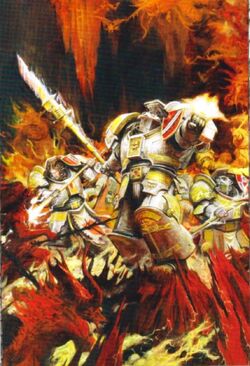
The Grey Knights combat a daemonic incursion into realspace
The Chaos Gods are not alone in Warpspace. They have created servants from their own essences -- the creatures mortals call daemons. Daemons are beings of a somewhat different nature to their masters, and are the most numerous of the Warp's inhabitants. A daemon is "born" when a Chaos God expends a portion of its power to create a separate being. This power binds a collection of senses, thoughts and purposes together, creating a personality and consciousness that can move within the Warp. The Chaos God can reclaim the independence it has given to its minions at any time; this ensures their continuing loyalty, and means although some wayward daemons may not act entirely in accordance with their master's commands, even the greatest of them would not dare outright defiance. As beings of pure entropic psychic energy and emotion, it is only through the loss of this animating essence that a daemon can be truly destroyed, its mind dissolving into the whorls and currents of the Warp.
Though it may appear to be made of normal matter when it materialises in realspace, a daemon's form is no more physical than it is in the Realm of Chaos. Outside of the Immaterium, daemons have particular invulnerabilities and weaknesses, as well as many destructive and terrifying powers derived from their Warp-born nature. Slaying a daemon's physical projection only severs its presence in reality, banishing it back into the Warp. While its true essence remains unharmed, the blow to the daemon's pride is considerable, and those that are forcibly returned to their own realm must endure the mockery and torment of their fellows until they can return to corporeal form and avenge themselves -- assuming they are not simply re-absorbed by their creator as the price of their failure.
In order to regain its form, a daemon must remain in a sort of purgatorial state within its master's realm. Legend has it that a daemon banished in this way cannot return to realspace for a thousand Terran years and a day, though it is of course impossible to prove such a belief through study, and the concept of time itself is meaningless within the Warp. Ultimately, how long the process takes depends upon the power of the individual daemon, the favour of its deity, and the current balance of power available to the god in question.
Daemons are a great threat to the peoples of the galaxy, for unlike their masters, they are not wholly confined to the Warp. At the behest of their divine patrons, they work to bring about the day when the barrier between Warpspace and the material dimension is collapsed altogether, allowing Chaos to spill through and the Dark Gods to rule all of Creation. Daemons are the agents of their Chaos God within and beyond this realm, for they are fractions of his will given physical form. Untold billions of daemonic entities make up the host of each of the Chaos Gods. These legions consist of Greater Daemons, Daemon Princes, Lesser Daemons, Daemonic Beasts and other creatures that defy easy classification by mortal savants. Spawned and destroyed by the needs and whims of their divine patron, the size of a Chaos God's forces swells and ebbs with the power he claims over the material dimension at any given time.
When the daemonic legions go to war, whether in the domain of their god's rival within the Realm of Chaos or against the galaxy's sentient species, they bring the power of their patron and all the madness of the Warp with them. The Immaterium trembles beneath their endless ranks, and in realspace, Warp Storms and unnatural phenomenon herald their coming. In performing the hellish machinations of their masters, the daemon legions are as relentless as they are utterly horrifying; they are the greatest and oldest fears of mortals made manifest, the antithesis of order and reason, and the death of reality itself. Against them, victory is seemingly impossible, and they are only growing stronger.
Though preoccupied by the machinations of their creators, all daemons lust after the worlds of mortal men. It is only there that the daemons can truly dominate and destroy, conquer and corrupt, for unlike the Realm of Chaos, the material universe can be permanently changed by their actions. For this reason, daemons constantly seek egress into the realm of mortals. When a Warp breach gives the daemon legions a chance to enter the mortal realm, all rivalries and vendettas are put aside. The numberless armies of the Immaterium burst forth, united by a shared goal -- the total conquest and subjugation of realspace. The daemon-hunting Ordo Malleus of the Inquisition fears that with the exponential increase in the number of humans in the galaxy who now manifest psychic abilities, the material dimension will soon be overwhelmed by these daemonic incursions. Once the Ruinous Powers have glutted themselves on the souls of all the mortals in the galaxy, their armies will fall upon each other like hyenas over a fresh corpse, but by then it will be too late. All that could exist in such a nightmare are the daemons themselves and those few mortals who survive by the sufferance of their new masters.
Being an intelligent entity of the Warp, a daemon cannot exist for long periods of time in realspace, any more than a mortal can survive unprotected in Warpspace. There are a few ways a daemon can breach the walls separating the Warp from realspace and gain entry into the material universe.
Possession
Daemons can possess mortals on the other side of the barrier between dimensions by transferring some of their psychic power into the mind of a psychically "gifted" mortal victim. The mind of a psyker is the most susceptible to this influence, which is why the Imperium so greatly fears and controls psychic individuals. The daemons appear in dreams and visions, infusing their mortal host with a portion of daemonic power. This eventually leads to the destruction of the possessed mortal, who is known as a Daemonhost, as their physical frame is warped by the daemon to suit its own inhuman aesthetic. A few mortals willingly allow themselves to be possessed, glorying in the superhuman abilities they gain, even though the energies they crave will soon destroy them. Though the physical and psychic power of a daemon is severely limited by the physical body it possesses, the scope for mayhem and carnage is still great. Possessed mortals, particularly those who already have power and influence, can start rebellions and wage wars, plunging whole worlds into centuries of bloodshed and anarchy. The history of the galaxy is littered with devastating conflicts caused by Imperial military commanders, belligerent army generals and political leaders who have been touched by a daemon's fell influence.
Some Heretics who serve Chaos Cults or the Ruinous Powers directly willingly offer themselves as Daemonhosts through daemonic pacts such as those pursued by the foul Possessed Chaos Space Marines. Another way to allow a daemon to manifest itself in the Materium is by preparing a suitable mechanical vessel for it to inhabit. Weapons and vehicles from Dreadnoughts to Cruisers can be ritually anointed through painstaking rituals and large sacrifices of mortal lives to serve as a host "body" for a daemon. This process is far from easy, as daemons dislike mechanical bodies for they are far more difficult to bend to their will and reshape than a biological one.
Daemonic Incursions
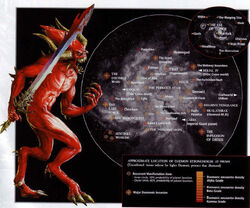
Daemonic strongholds in the Eye of Terror, ca. 998.M41
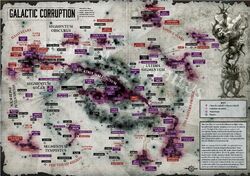
Known Warp Storms and Daemon Worlds afflicting the galaxy after the formation of the Great Rift in 999.M41
In order for a daemon to break through into the mortal universe, there must be a breach of the barriers between Warpspace and the material realm -- a Warp rift. These are breaches in the fabric of reality that can vary in nature and size, such as the massive Eye of Terror or the Maelstrom. Sometimes these occur randomly; at other times, either mortals or the Chaos Gods themselves bring about their creation by some supernatural act. The size of the breach can vary tremendously, from a slight thinning of the dimensional walls to immense wounds in reality that allow the daemonic legions to invade en masse.
At times when certain conditions like the appearance of a Warp Storm or a sorcerous ritual have weakened the barrier between the Warp and realspace, a daemon can possess a mortal and turn him or her into a living portal through which whole daemonic hosts can pass for a time into the material universe. These daemonic incursions can taint realspace severely, often twisting and reshaping whole planets until they are lost into the Warp, becoming a part of the Immaterium and thus transformed into Daemon Worlds. It is not surprising that the Inquisition's Daemonhunters, the Ordo Malleus, are granted unlimited resources and political power by the High Lords of Terra to deal with such terrible threats to the continued existence of Mankind.
Often, it is the tumultuous movements of the Warp itself that create a break into the material realm, allowing daemons to spill through the resulting breach. This might happen by chance; events such as the onset of Warp Storms, Warp-Drive implosions or a rogue psyker's mind suddenly exploding with raw power can cause a rift to appear into the Immaterium. At other times, the deliberate rituals and blood sacrifices of Chaos-worshipping mortals can allow the teeming hordes of the Chaos Gods to smash through into the material realm. Sometimes, simple mortal suffering, death and misery on a massive enough scale can form a Warp rift that a daemonic legion might use as a portal. Some Warp rifts last mere hours, or even moments, for the nature of Chaos is ever impermanent. A daemonic army that has passed through such a rift can become trapped in realspace and will swiftly succumb to the constant leeching of the Chaos energy required to maintain its presence.
Of these, the greatest and most dangerous Warp rift is the Eye of Terror, which has lasted for more than ten thousand standard years. The Eye can be seen as a purple-red bruise upon the firmament from fully half the worlds claimed by the Imperium. It was created by the birth of the Chaos God Slaanesh in the early 30th Millennium and is home to unnumbered Daemon Worlds fought over by daemons and mortals alike, the infamous Traitor Legions of the Chaos Space Marines amongst them. Another Warp rift of excessive magnitude is the Maelstrom, found near the galactic core and a haven for thousands of pirates and Renegade Space Marine Chapters. Other, less widely known Warp rifts exist, such as the Heart of Darkness near to the world of Atilla, the Storm of Judgement that engulfs almost all of the Caradryad Sector, Hell's Gullet, which threatens to swallow the Berillian System whole, and the infamous Screaming Vortex that marks the border between the Calixis Sector and the frontier of the Koronus Expanse in the Halo Stars.
Random Warp rifts are often caused by Warp Storms -- roiling expanses of turbulence within the Realm of Chaos that are echoed in realspace, restricting Warp-dependent travel and communication. If they become focussed or powerful enough, they can pull the fabric of reality taut or even tear it open. Compeletely unpredictable, Warp Storms can be isolated to single planets or expand to encompass whole sectors. One of the worst Warp Storms ever recorded in human history cut Terra itself off from the rest of the galaxy for the entire 5,000-year-long epoch known as the Age of Strife. The unfortunate worlds in the vicinity of such a cataclysmic event can become the playgrounds of daemons until the storm finally expends itself. A few Warp Storms have endured for so long that they can be considered permanent, their self-sustaining energies trapping nearby planets and star systems in a quagmire of roiling Chaos.
Without the Warp, there would be no psykers, no interstellar travel and no interplanetary communication. In fact, the Warp is essential to the survival of humanity. Spacecraft travel through its shifting tides, capable of travelling thousands of light years in a fraction of the time a journey using conventional reaction drives at sub-light speeds would take. By such means, humanity is bound in a single interstellar Imperium, led by the divine Emperor of Mankind.
Through astrotelepathy and the guidance of the psychic mutants known as Navigators, the worlds of the Imperium are able to maintain their fragile bonds. The Emperor's will may be mighty, but His reach is long only because His fleets can travel through Warpspace, the fragile bubbles of reality that protect each warship held up by complex Geller Fields and raw faith.
While Mankind would have a fraction of its current numbers and strength without the Warp, Chaos in its turn would be much diminished without the presence of humanity in the galaxy. The Chaos Gods drink emotions and thoughts, growing bloated with psychic power in the process. Over the millennia, each has fed on an aspect of human nature: rage, desire, corruption and inconstancy. Strengthened and moulded by the collective thoughts and emotions of the inhabitants of reality, the Dark Gods nurture in Mankind those same passions that sustain their very existence. As humanity has spread across the stars, its numbers have grown immeasurably, fuelling the Chaos Gods. So the circle is established, with mortal follies and weaknesses feeding the Dark Gods and those same gods then encouraging Mankind in turn to further follies and weakness.
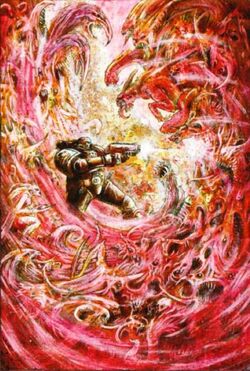
A lone Space Marine confronts a hellish daemonic incursion into realspace
Humanity has long been able to use the power of the Warp -- magicians, seers, witches, mediums, shamans and exorcists have all trapped into its power across the breadth of human history, albeit often unwittingly. Psykers such as these manifest their powers by drawing upon the Warp, siphoning its unnatural energy to hurl blasts of energy, teleport objects, send their thoughts across space and time and perform countless other "miracles." Once, the gift of true psychic power was confined to only a few helpless individuals who usually fell victim to superstitious prejudice in Mankind's distant past. However, the number of psykers is rising in the galactic population of humanity with every passing century. This constitutes a profound evolutionary change for Mankind. Every time a psyker draws upon the Warp, he disturbs its natural flow, creating an eddy that may simply die away or be fed by other movements until it becomes a raging tempest that feeds a Chaos God. Each psyker causes a pinprick of disturbance within the Warp; each can be the seed of a Warp Storm; each can rouse a Chaos Power to unthinkable conquest.
The invasion of a daemonic army is analogous to hell being unleashed upon reality. Free from the physical limitations of a mortal force, a daemonic legion can appear and disappear at will. On occasion, it will mass for a great attack; at other times, individual packs of daemons will hunt across the affected globe, terrorising the populace, randomly enslaving and killing. Those mortals with even the least psychic potential suffer first as the influx of Warp energy releases the latent power of their mind, immolating them with magical fire, turning them into rocky statues, or causing their brains to simply explode. Poltergeist activity and random bursts of pyrokinesis can ruin buildings in an instant. People hear deranged screams and lurid whispering whilst unnatural stenches taint the air.
A daemonic invasion is all but impossible to stop by conventional means, for the very act of warring against daemons feeds the psychic power keeping them in realspace with fear and hatred. Only the closing of the Warp rift can deprive the daemons of their power. Often, there is nothing that can be done but battle against the incursion until the Warp rift runs its course. Battles fought against a daemonic incursion are utterly different than those against mortal foes, for defensive structures and garrisons have little to no effect. To wage war against invading daemonic hosts, an army must be ready to respond to the most sudden appearances of its adversaries.
To compound matters, the motivations behind daemonic incursions are unfathomable. Even the Tyranids, who are so alien as to be beyond the ken of man, war for sustenance and survival. Instead of these base drives, the objectives of a daemon commander will often be completely obscure -- they might be to slay a million mortals, to retrieve a single artefact, or to kill the grandchildren of those that once banished them back to the Warp. Other times, the Daemons have no goal or plan at all, and the gibbering creatures of the Immaterium make decisions according to opportunity and their intrinsic nature.
To fight a daemon army is to fight a twisting tornado of unreason and despair. Even then, the Imperium cannot allow the knowledge that such foes actually exist to spread. The human survivors of such conflicts are invariably confronted by the Inquisition and mind-wiped, quarantined in forced labour camps or even -- in extreme cases -- become the subjects of a worldwide Exterminatus event. Over the aeons, the galaxy has witness Warp-based catastrophes and daemonic incursions beyond counting. Since the inception of the Imperial Inquisition in the early days of the Horus Heresy, even the fact that such a thing is possible is deemed too dangerous for the citizens of the Imperium to know, for such knowledge breeds heresy as surely as a flyblown corpse breeds maggots. Because of this, the vast majority of knowledge concerning daemonic incursion has been eradicated from extant Imperial public records. What is known is recorded only in proscribed Imperial texts and heretical xenos scripts that the Inquisition has yet to destroy.
Bound Daemons
Although Daemons are driven to act in certain ways according to their nature and the will of their patron power, it is possible for sorcerous rituals to bind them into acting at the behest of a mortal summoner. Some cults serving the Ruinous Powers bind Daemons to gain greater power, while Radicals among the Ordo Malleus sometimes hope to turn the power of Chaos against itself. However, Daemons do not accept the bonds of servitude easily, regardless of the identity of their would-be master. A bound Daemon is even crueller and more vicious than others of its type, and does what it can within the limits of the binding to ensure that its summoner suffers for his temerity.
The exact reaction of a Daemon to binding can vary somewhat, primarily depending on the type of Daemon in question. Daemonic beasts such as Furies or Flesh Hounds are accustomed to servitude, and rarely turn on their masters unless they are denied prey or shown signs of weakness.
Daemons of Khorne constantly test the extent of their binding, pitting themselves against any constraints in a fierce contest. Their masters can appease them somewhat by providing a steady supply of targets for their wrath, but only a truly indiscriminate slaughter can distract the Daemon from its ire.
Binding tests even the good humour of Daemons of Nurgle, but they often seem to endure it more readily than others. In truth, these Daemons are typically playing the long game, waiting for the strength of the bindings to erode and fall apart. Until what they see as their inevitable freedom arrives, they might make light of their situation and serve with seeming cheer, even as they await the collapse of their prison.
Submission to the will of a mortal is nearly intolerable for the egotistical Daemons of Slaanesh. They are less accepting of binding than any, save perhaps Khorne’s Daemons, although they are often more capable of putting on a front of acceptance. While bound, a Daemon of Slaanesh invariably seeks to tempt its summoner into releasing any constraints, offering extravagant promises and lies in exchange for its freedom. Anyone weak-willed enough to succumb soon finds themselves exposed to depths of pain that only a master of sensation could even imagine existing.
As in so much else, the reactions of Tzeentch Daemons to binding are varied and often inscrutable. They may invoke their sorcerous powers to undo any restraints on their behaviour, or play along with a failed ritual as if they were bound in order to deceive their summoner with false counsel. They do not like servitude any better than other Daemons do, but they often view it as a circumstance like any other they weave into their plots, and attempt to turn the tables on their master in some cunning ploy.
The binding rituals used by the Ordo Malleus, even among the most Radical of Inquisitors, are typically more restrictive than those used by Chaos cults. Containment of the Daemon’s threat is viewed as a first priority, and while the blessed chains and sorcerous wards that hold the Daemons infuriate them above even normal mortal insolence, they are often less able to act on this frustration than a Daemon bound more loosely. Such a Daemon struggles constantly -- and usually futilely -- at its bonds, feeling a hate for its condition that a mortal could barely comprehend. Such a Daemon may affect servility or submission, but only as a ruse to lower the guard of its master or deceive him in some way.
True Names
A Daemon might be known by hundreds of names and titles on thousands of worlds, but it can have only one True Name. These originate within the madness of the Warp, not from any human language. As such, they are extraordinarily difficult to speak, both for the odd sound and structure of the syllables, and for the otherworldly power contained therein. Daemons jealously guard them, for to know a Daemon’s True Name is to have power over it. The discovery of even a minor Daemon’s True Name is a monumental feat for a practitioner of the dark arts, one that he may work many lifetimes to achieve. In the creation and control of a Daemonhost, knowing the Daemon’s True Name is a great advantage, and the knowledge of its True Name is often what marks a Daemon out for binding. Certain dark tomes, heavy with the evil they contain, record rituals and rites specific to a single Daemon, including its True Name. As these tainted manuals pass through the hands of different occultists through the centuries, a Daemonhost might be bound again and again. Though it inhabits a different host body each time, it contains the same malefic intellect, and the same dark changes mark its appearance.
The Great Rift
With the opening of the Great Rift at the end of the 41st Millennium, the daemonic incursions that had plagued the galaxy since time immemorial escalated in both scale and frequency. A new era of terror and bloodshed was ushered in by that galaxy-spanning tear in the fabric of reality, and the armies of the Chaos Gods, mortal and daemonic alike, began to conquer and consume the worlds of Humanity and the alien races with unprecedented impunity.
Had the Chaos Gods worked in unison in the wake of that terrible event, it is doubtless that realspace would have been utterly consumed by the sprawling madness of the Warp. Yet true to their nature, the dark brothers saw the anarchy as an opportunity to fulfil their own agendas: to kill, to change, to pollute, to bathe in excess. So divided, they are unable to fully overcome the fierce resistance of the galaxy's inhabitants.
The Imperium of Man, the largest single empire in the galaxy, has been galvanised by the return of the legendary Primarch Roboute Guilliman, and with him fights a new breed of warrior in Humanity's defence, the Primaris Space Marines. The older races of the galaxy, such as the Aeldari and the Necrons, continue to exhibit a stubborn refusal to bow before the Chaos Gods and accept their extinction, while upstart new species like the T'au gain a greater understanding by the day of the Realm of Chaos and the ancient and malevolent beings within it. The barbaric Orks are only incited by the surging conflicts around them, and greet the prospect of battle against the daemonic legions with the same reckless enthusiasm they always have. The intergalactic devourers known as the Tyranids regard the immaterial daemons with a special distaste, seeing them only as undigestible threats to the biomass they wish to consume. So the ultimate battle for the galaxy continues, the Chaos Gods and their daemonic legions threatening to annihilate everything, including each other, in their eternal quest for dominance.
Types of Daemon
Greater Daemons
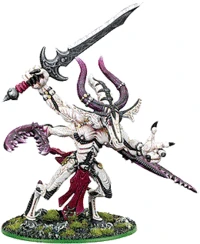
Keeper of Secrets, a Greater Daemon of Slaanesh
At the top of the daemonic hierarchy are the Greater Daemons whose power can be variable, depending on the whims of their patron Chaos God upon their creation. Some, like Nurgle's Great Unclean Ones, are only slightly less powerful than their patron God and in some cases they serve as temporary avatars of that God. Others, though immensely powerful by mortal standards, are allowed to embody only a fragment of the true collective power of their patron. Greater Daemons act as the wardens of their patron's realm in the Immaterium and have authority over the Lesser Daemons of their respective God. It is often they who lead daemonic incursions into the material universe. Such is their might that they cannot simply be summoned by mortal Chaos Cultists performing a sorcerous ritual like Lesser Daemons. A Greater Daemon needs to possess a mortal's living body in order to fully manifest itself in realspace unless a Warp rift or Warp Storm has come into being, essentially eliminating the barrier between the Immaterium and the mortal world.
- Great Unclean One, Greater Daemon of Nurgle
- Keeper of Secrets, Greater Daemon of Slaanesh
- Lord of Change, Greater Daemon of Tzeentch
- Bloodthirster, Greater Daemon of Khorne
Daemon Princes
The most powerful mortal devotees of Chaos try to gain the attention of their Dark Gods in order to gain the terrible power and great rewards that the Ruinous Powers can bestow upon their most favoured servants. Those striving in the pursuit of their God's designs are known as Champions of Chaos, whose ultimate, driving goal is to transcend mortality itself by becoming a Daemon Prince. Those mortals who become Daemon Princes are counted among the most powerful of the servants of Chaos, second only to the Chaos Gods and their Greater Daemons themselves. However, this path can as easily lead to another extreme. Throughout the path to power the Champion undergoes constant change, until either his patron Chaos God judges him worthy of daemonic ascension or his form finally is overcome by the accumulated mutations given through loyalty to Chaos and he devolves into a mindless Chaos Spawn. The goal for most mortal Chaos Champions is to be elevated to the rank of a Daemon Prince in the service of one of the Ruinous Powers or of Chaos Undivided. This was the reward granted to the surviving Primarchs of the Traitor Space Marine Legions who fell to Chaos during the Horus Heresy.
Lesser Daemons
Lesser Daemons are the foot soldiers of Chaos, providing the core of the Daemonic Legions. They are usually anthropomorphic in appearance and possess a calculating, malevolent intellect. Among the Daemons of Chaos they are the ones most likely to answer the summoning calls of mortal heretics who engage in blasphemous, sorcerous rituals to call forth these entities into realspace.
- Bloodletters
- Plaguebearers
- Daemonette
- Flamers of Tzeentch
- Horrors
- Nurglings
Daemonic Creatures
These more primal Warp entities are the lowest type and least intelligent of the daemons. They are often granted as servants to other daemons and occasionally, one of the Chaos Gods' more powerful mortal followers or Champions. Daemonic creatures can be further divided in type between Daemonic Beasts and Daemonic Steeds.
Daemonic Beasts
Daemonic Beasts are driven by a feral intellect and commonly used as hunting beasts by the Forces of Chaos.
- Beast of Khorne: Flesh Hound
- Beast of Nurgle
- Beast of Slaanesh: Fiend of Slaanesh
- Beast of Tzeentch: Screamer
Daemonic Steeds
Daemonic Steeds are prized mounts used by the more experienced Champions of Chaos. Earning one of these creatures from the Ruinous Powers can be as dangerous as facing them in battle.
- Steed of Khorne: Juggernaut
- Steed of Slaanesh: Mount of Slaanesh
- Steed of Tzeentch: Disc of Tzeentch
- Steed of Nurgle: Rot Fly
Unaligned Daemons
Apart from the four major Ruinous Powers that form the Pantheon of Chaos Undivided, there are numerous minor daemonic entities in the Warp who are Chaotic in nature too. The Chaos Gods tend to have less direct control over them, though they still serve the overall universal force that is Chaos:
- Astral Spectre - Spectres are powerful entities composed of congealed psychic energy and Warp-stuff. When manifest in the physical world, they take the shape of incorporeal spectres: patches of moving darkness, unnatural mists boiling with flickering images, half-transparent figures that cast no shadow and a host of other forms.
- Dispayre - Famished and tattered figures with hollow eye-sockets and mouths frozen in endless silent screams, Dispayres serve no single great power; they desire only to bring sorrow and madness. Darkness clings about them, and they make formidable stalkers and assassins for malefic cults.
- Fury - A Fury is a Daemonic beast of Chaos Undivided. Ancient lore suggests that human servants of chaos that display a tepid attitude towards Chaos as a whole, reject the patronage of any of the gods, and who's service to Chaos in their life as a whole was unremarkable, are reborn in the warp as these beings. Forever to soar the violent winds of the warp without a place.
- Soul Grinder - Soul Grinders are former Daemons of Chaos that now, in general, serve Chaos Undivided. They are dedicated to the Forge of Souls, an organization of daemonic smiths in the Realm of Chaos which is independent of the control of any of the major Chaos Gods and uses Soul Grinders to maintain that independence.
- Warp Predator - Warp Predators are near-mindless animalistic creatures whose hunger for life is boundless. They are drawn to the soul sparks of mortal life like sharks to bloody water. Once such predator is the Ebon Geist, a thing blacker than the emptiest void, a killing shadow, thin and writhing that can pass through dark spaces as insubstantial as a nightmare fading into forgetfulness. The Geist murders with its chill talons, leaving nothing but bodies consumed to desiccated husks, the screaming shadows of its victims cold-burned into the hull where they perished.
The Daemonic Legions
The Blood Legions
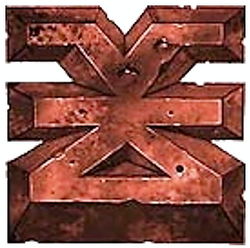
The Mark of Khorne
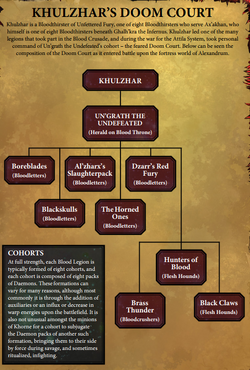
Khulzar's Doom Court, an example of a single one of eight cohorts drawn from a daemonic Blood Legion of Khorne; the Doom Court was personally led by the Bloodthirster Khulzar during the Blood Crusade in the Attila System; this order of battle reflects the cohort as it entered battle on the Fortress World of Alexandrum
Of all the Chaos Gods' daemonic armies, it is the Blood Legions of Khorne that are the most martial. Though they are savage and unrestrained creatures, daemons of the Blood God occupy a strict hierarchical structure based on sheer might. Khorne's belief that the strongest of his followers should dominate has proven to be a simple but highly efficient organisational methodology.
The legions of the Blood God have carved out the largest of all domains in the Immaterium through incessant war. In the brutal press of melee on the battlefield, Khorne's forces are unmatched by those of any other god, and the strength and ferocity each of his daemons exhibits there decides where they rank in his armies.
Highest in order are the Bloodthirsters. Clad in baroque armour, wielding fearsome brass axes and whips, each is a demigod of war. Were they simply warriors and nothing more, Khorne's Greater Daemons would be terrifying enough. His foes are not so fortunate, however, for the Bloodthirsters are tasked with leading the Lord of Skull's Blood Legions on the battlefield; there they bark guttural orders to the ranks of Lesser Daemons around them, and assert their dominance and dedication to Khorne by defeating the mightiest of the enemies' combatants. Figures of awe amongst the servants of the Blood God, they often attract an entourage of daemonic champions that follow them into glorious battle.
Each Blood Legion is divided into eight cohorts, which are individually comprised of eight packs of daemons led by a Herald of Khorne or a Daemon Prince. The exact composition of these cohorts, and the auxiliary formations and creatures that may fight alongside them, will often depend on the type of Blood Legion they belong to. For instance, the heart of Red Tide Legions is made of Bloodletter cohorts that overrun the foe with waves of infantry attacks; such is the scale of death around them that they will often be followed by packs of carrion-feeding Furies. In contrast, the Hellfire Legions are siege specialists that prefer to engage the foe at range, and go to war in the shadows of Skull Cannons, Soul Grinders and, in the greatest of conflicts, the massive Daemon Engines known as Lords of Skulls. The Brazen Thunder Legions are the most mobile of Khorne's armies; the ground shakes beneath their Blood Thrones and the Bloodcrushers they lead, while Flesh Hound packs chase down any that attempt to flee. Exactly how many types of Blood Legion exist is known only to Khorne himself.
At full strength, each Blood Legion is typically formed of eight cohorts, and each cohort is composed of eight packs of daemons. These formations can vary for many reasons, although most commonly it is through the addition of auxiliaries or an influx or decrease in Warp energies upon the battlefield. It is also not unusual amongst the minions of Khorne for a cohort to subjugate the daemon packs of another such formation, bringing them to their side by force during savage, and sometimes ritualized, infighting.
The Scintillating Legions
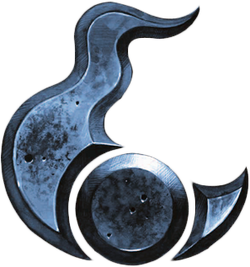
The Mark of Tzeentch
The air fills with kaleidoscopic bursts of magical energy as the convocations of the Great Conspirator materialise for battle. To mortal eyes, the different daemonic legions of Tzeentch are impossible to distinguish, each one as bizarre as the next, yet there is method within the madness -- although none save the Architect of Fate himself could truly comprehend it.
While Tzeentch prefers to further his ends through sorcery or schemes, there will often be no better alternative than force to achieve his goals. Thus are Tzeentch's daemon legions deployed, armies unlike anything seen in realspace. These convocations go to war in a capering, bounding, spell-wielding carnival of violence, obliterating foes with hellfire and change-magics. Unlike the militant cohorts of Khorne or the cyclical forces that serve Nurgle, Tzeentch's legions are often in flux, shifting composition or altering tactics to better serve their master.
Each Scintillating Legion is commanded by one of Tzeentch's Greater Daemons, a Lord of Change, each utterly dedicated to his master's cause. A Lord of Change is granted great independence to operate, and with the help of their advisers and champions, they will command a legion suited to their own proclivities. Those that love to bask in the glow of destruction might head a Conflagration Legion -- a force centred around formations of Flamers, capable of wielding the most powerful of Warp-flames. Others favour the Legions Anarchus, which are far less predictable in composition and specialise in sudden and wholly unexpected incursions. Those Greater Daemons who are masters of duplicity will lead one of the Veiled Legions; the most mysterious of Tzeentch's forces, these surface rarely and are almost never brought to battle, and slip off unseen after their plan's culmination.
Each of Tzeentch's daemonic legions is divided into nine hosts, and these are directed in battle by Daemon Princes and Heralds such as Changecasters, Fluxmasters and Fateskimmers. The leaders of the hosts compete to attract more praise from the Lord of Change that commands them, and even between the legions, there is no end to the machinations as rival Lords of Change plot against one another and sabotage each other's plans. It is another game within the Great Game, and one beloved most by the Great Schemer himself, who frequently weighs the tributes paid to him and proclaims his judgement. Thus do the sigils of each daemon legion dance across the Pyramid of Yrch deep in the Crystal Labyrinth, blazing into a new order of countenance. It is a hierarchy that moves often, but the nine most favoured daemonic legions are each granted control of one of the Fractal Fortresses that tower over the Crystal Labyrinth, an honour all Tzeentch's servants desire to attain.
The Plague Legions
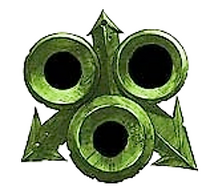
The Mark of Nurgle
To those subjected to their loathsome assaults, the legions of Nurgle seem like an amorphous mass, but amidst the shambling anarchy there is purpose and design. Like the stages of the diseases they carry, each Plague Legion is part of an overarching cycle of fecundity and decay, and exists only to see Nurgle’s garden flourish and his gifts bestowed.
From the Garden of Nurgle lumber the Plague Legions, the dreaded armies of the Great Corrupter. When they go to war, be it in the Realm of Chaos or realspace, they bring the boundless generosity of their master and the products of his endless labours with them, and leave contagion, anguish and death in their wake.
All Plague Legions are Nurgle's creations, and so carry pestilence and propagate their master's foul will, yet each is associated with specific stages of the Fly Lord's cycle of decay and regeneration. The Fecundus Legions are tasked with the making of diseases; it is they that travel across reality and unreality to gather the raw ingredients that will be added to the cauldron of their foul god, and the worst ills suffered by the mortal races can be attributed to their diligence. The Infecticus Legions are the harbingers of infection, the carriers of new diseases that lay the groundwork for the greater virulence to follow. The Pathogenus Legions are disease fully bloomed, sickness made manifest, the very height of contagion; they are equally capable in both attack or defence, and will be often be deployed to guard key sites within Nurgle's Garden or spearhead an assault. The Epidemic Legions contain the most daemons, for they expand, proliferate, and regenerate; it is they that spread outwards, ensuring initial gains turn into rampaging outbreaks. The Rot Legions revel in decay, their festering powers and potent blessings able to break down anything; more than any other daemonic legion, their presence cultivates the ground for the Garden of Nurgle to spread. The Morbidus Legions are the reapers, the tolltakers, and the bringers of death. The Necroticus Legions are the most resilient; they use hopelessness and despair as a weapon, and can absorb terrific punishments. And on it goes, each of the daemon legions of the Plague God specialising in some grotesque aspect of Nurgle's cycle of birth, decay, death and rebirth.
Each Plague Legion is led by a Great Unclean One, a Greater Daemon of Nurgle that acts as its general. They dote over their charges in the manner of a loving parent, cajoling each of their Plague Legion's seven Tallybands upon its appointed tasks. Ever eccentric, Nurgle encourages the same aberrations amongst the most powerful of his shepherds. These unusual traits go as far towards colouring the composition and tactics of the army they lead as does the daemon legion type itself. Some Great Unclean Ones, for example, favour entirely airborne assaults, going to battle with clouds of Plague Drones that darken the skies and excel at aerial strikes. Others enjoy seeing their victims buried in slavering Beasts of Nurgle, or ground slowly into the dirt by wave after wave of mumbling Plaguebearers.
Great Unclean Ones cycle through phases over the course of their immortal lifespans, assuming new mantles with each new legion they take command of; for example, they may lead an Epidemic Legion to spread diseases before moving on to command a Rot Legion in order to bask in such maladies. When the cycle nears its end, a Great Unclean One will scab over with necrotic patches, and in his state of advanced decay will lord over a Necroticus Legion. It is not long before his body will shed the rotting husk of its old skin to reveal the new blooms of fresh disease, and it is then he will once again lead a Fecundus Legion.
Beneath the Great Unclean One are the leaders of the Tallybands, either Daemon Princes or daemonic Heralds of Nurgle such as Poxbringers, Sloppity Bilepipers and Spoilpox Scriveners. Each receives a grandiloquent title of the general's invention, selected to match the bearer's skills, proclivities, or war tasks. Examples include the Lords of Fulsome Filth, the Almighty Bringer of Rancid Decay, or the Sloptoxic Master of Bubbling Buboes.
The Tallybands can vary in size, swelling to epidemic proportions as Nurgle's power waxes in the Realm of Chaos or contracting into small, elite warbands when it wanes. At its peak, however, a Tallyband is composed of seven packs of the Lesser Daemons known as Plaguebearers or Plague Drones. Depending upon the predilections of its leader, and the ebb and flow of the cycle, a Tallyband may also include Beasts of Nurgle or swarms of Nurglings, although such anarchic beasts rarely remain with the formation beyond the duration of a single battle.
The Legions of Excess
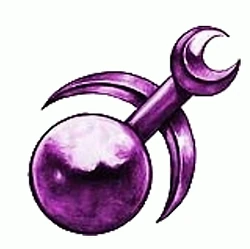
The Mark of Slaanesh
Slaanesh's Legions of Excess strike with a sinuous grace, hitting the foe in a whirling blur of lithe and bladed limbs. As they do so they are at once horrific and alluring, mesmerising and loathsome. Slaanesh's daemonic legions vary in composition and purpose, but all desire to spread their lord's corruption.
Slaanesh uses temptation and the promise of pleasures to seduce mortals and daemons alike, and thus are many brought into submission by the Dark Prince. These insidious tactics take time, however, and often a less subtle approach is required to fulfil Slaanesh's whims. When the souls of mortals need to be forcibly cut from their bodies rather than given willingly, or a territory within the Immaterium must be fought over, Slaanesh calls upon his daemonic armies -- the Legions of Excess. Although Slaanesh's forces cannot match the raw power of Khorne's cohorts, the resiliency of Nurgle's Tallybands, or the eldritch might of Tzeentch's hosts, they are possessed of a speed and lethality that is unequalled in the Immaterium and realspace both.
A god of whims and bizarre fancies, the Dark Prince encourages such personal fulfilment in his generals, the Keepers of Secrets -- the dark heart of a Legion of Excess. There are also noted instances of Legions of Excess being led by Daemon Princes, for Slaanesh lauds the greatest of his once-mortal champions perhaps more so than any of his brothers. While some of the Dark Prince's generals are obsessive in commanding a single type of daemonic legion, the majority will change formations as mood or need suits them.
Each type of Legion of Excess varies greatly in both composition and the tactics they employ. The Flayer Legions are given over to wanton destruction, and their many Daemonettes take great pleasure in the act. The Hunter Legions are masters of the quick kill, and are built primarily around fast-moving cavalry and chariots; they are ideal for tracking down specific quarry, for Slaanesh always collects his due. The flamboyant Glamiatrix Legions are the most sorcerous, relying heavily upon psychic powers and mesmerism. The Terror Legions are a shock force, specialising in elaborate, gory displays of combat; they are infamous for unleashing a barrage upon the senses that can overwhelm weak-willed enemies. The Legions of Eternal Punishments have no speciality, but rather call upon all the damnations of Slaanesh, intermixing facets of magics and temptation alongside their finely honed battle-craft.
Perhaps strangest of all the Legions of Excess, however, are the Courante Legions. To them, battle is but a dance; their garish daemons whirl about one another as they slay the foe in bizarrely choreographed manoeuvres. While they lack the speed and pursuit of the other types of Legion of Excess, the elegance and creativity with which each kill is carried out often capture the favour of their divine master in a way that more practical assaults could never hope to emulate.
Beneath the Keepers of Secrets in hierarchy are the Heralds of Slaanesh or Daemon Princes that each lead one of the legion's subunits, known as "cavalcades." Of these formations there are six in total in each legion, for that is the sacred number most often associated with Slaanesh. The main body of troops in most cavalcades are the Lesser Daemons known as Daemonettes, the handmaidens of the Lord of Pleasure. The cavalcades of those legions with a predilection for speed or hitting power, such as Hunter or Terror Legions, will often include a large number of Seeker cavalry, Seeker Chariots and Hellflayers in support of Daemonette packs. Any of the legion types can include the beasts known as Fiends, but they appear in greatest numbers in Glamiatrix and Terror Legions, and are infrequent in Courante Legions.
Daemonic Relationships with Mortals
Mortal worshippers of the Chaos Gods can interact with daemons in ways other than simply fighting alongside them.
Possessed Chaos Space Marines
Some Chaos Space Marines willingly allow daemons to inhabit their bodies so that they can enter the physical universe. Rather than the daemon completely taking control, as in the case of possession by a Greater Daemon, these Lesser Daemons form an amalgam of Chaos Space Marine and daemon commonly referred to as a Possessed Chaos Space Marine, or simply the Possessed. The Possessed are potent warriors, combining the abilities of a Chaos Space Marine with the sorcerous psychic powers of a daemon.
Closely related to the Possessed are Obliterators, which are mysterious, daemonically-warped Chaos Space Marines. They have become an amalgam of a Chaos Space Marine, a Lesser Daemon and heavy armor, and bear the ability to transform their bodies into powerful weapons, making them walking gun platforms. Obliterators have their own cult, which is most closely connected to the Iron Warriors Traitor Legion. It has since been learned by the Inquisition that the Obliterators were once the Techmarines of the Traitor Legions, horribly warped and transformed by their ten millennia of exposure to Chaos.
Daemon Weapons
Some daemons can be forced into servitude by being imprisoned within the physical structure of a personal weapon; these mighty artefacts of Chaos are called Daemon Weapons. Daemon Weapons are extremely rare, but also very powerful, often able to tear apart reality, shoot powerful sorcerous bolts of psychic energy, grant their wielder extraordinary physical attributes, or perform other such unnatural feats. A Chaos Warrior must exercise great caution with these weapons, however, as the imprisoned daemon will often try to rebel against its master and attempt to devour the wielder's soul.
Chaos Spawn and Daemon Princes
As a mortal worshipper of Chaos grows more powerful with each of his victories in the name of the Ruinous Powers, his patron God or Gods will sometimes reward him with mutational "gifts"; by the same token, with each failure, the God could also curse him with the same changes. However, the Chaos Gods are notoriously fickle and often bestow their gifts of change without rhyme or reason. These gifts can include mutations such as extra arms, tougher skin, wings or the ability to shoot fire from one's hands, equipment such as exotic weapons or powerful armour, or even daemonic followers such as the Daemonic Mounts. With each gift, the warrior becomes partly daemonic himself, being tied more and more to the will of his God and becoming more and more a slave to that entity's will. As a servant of Chaos continues to distinguish himself, and successfully carry out his God's desires, this individual will continue to receive Chaotic gifts. These gifts can grant the receiver untold arcane powers that will make him potentially as powerful as a Greater Daemon. As the Chaos warrior attains more and more gifts, he will ultimately face only one of two possible fates for a mortal in the service of the Ruinous Powers:
- If the warrior receives too many gifts and is unable to endure any more, he can be transformed into a Chaos Spawn. Some particularly powerful Chaos Sorcerers have the ability to grant this dubious "gift" to a foe, instantly mutating them into a Chaos Spawn. Any servant of Chaos who has spent too much time in contact with the warping power of Chaos or the Immaterium -- perhaps through dwelling in the Eye of Terror -- may become a Chaos Spawn, even without the intervention of the Chaos Gods. Chaos Spawn are wildly mutated beasts of varied physical form, no two exactly alike, and are generally insane or non-sentient. A Chaos Spawn lives out the remainder of its pitiable existence at the whim of its God, serving as both gibbering cannon fodder for the armies of the Ruinous Powers and as a warning of the consequences of failure to all the servants of Chaos.
- A particularly successful Champion of Chaos who is able to withstand the "gifts" of his God and successfully champion the goals of the Ruinous Powers on multiple occasions can eventually become an exalted Daemon Prince. A Daemon Prince is among the most powerful beings that can be found on the battlefields of the Warhammer 40,000 universe. They are frequently massive in size -- much larger than a man and at least 10 feet in height -- and are very skilled warriors with the experience of hundreds of campaigns behind them. Like all daemons, Daemon Princes possess many potent psychic abilities. There are two types of Daemon Prince: those who have fully and willingly abandoned their mortal, physical form and have become a daemon in their own right and those who have not yet lost their mortal form. The first type can display many of the powers of a Greater Daemon, but specialised anti-daemonic weapons and psychic powers can be used to banish them to the Warp; the latter, while powerful and infused with the psychic powers of the Immaterium, are immune to such weapons, but can still be slain by purely physical means.
Daemonhost
Some especially Radical Inquisitors of the Ordo Malleus believe that one of the best ways to defeat the Chaos Gods is to turn their own followers against them. To this end, they will force a daemon into possessing a human body and, using powerful psychic spells, rituals and charms, bind it to the Inquisitor's will. These enslaved daemons are called Daemonhosts, and they are sometimes brought to the battlefield where they use powerful daemonic abilities to destroy the Inquisitor's foes. However, such Inquisitors are seen as dangerous heretics by their more conservative Puritan brethren, and sometimes find themselves being hunted as though they were traitorous heretics themselves; by the same token, other Imperial forces will usually hesitate at the prospect of fighting alongside a daemon, as this is heretical in the extreme. The Grey Knights in particular despise the thought of these so-called daemonhosts, and refuse to fight next to such abominations to the will of the Emperor under any circumstances. Chaos Cultists and Chaos Sorcerors will perform the exact same ritual, albeit for a different purpose, in order to have daemons that are able to maintain a physical form, but still possess many of the strengths of a daemon. Certain Chaos Space Marine leaders, notably Abaddon the Despoiler, will bind his daemons in such a way that they possess little free will.
Daemon Engines and Daemonically-Possessed Vehicles
Daemon Engines are similar in nature to Daemon Weapons; they are special tank-like machines which are forged in the realm of the Dark Gods and controlled by an imprisoned daemon. They frequently carry powerful cannons which make them useful in sieges. The most common type of Daemon Engine is the Defiler created by the Traitor Legions since the end of the Horus Heresy, a large spider-like combat walker mounting the battle-cannon typical of Imperial Guard main battle tanks like the Leman Russ. In contrast to Daemon Engines, daemonically-possessed vehicles are normal tanks and other Imperial armoured vehicles that have had a daemon sealed within them through the use of Chaotic sorcery, allowing it to control the vehicle in place of the normal Machine Spirit. This can be a strong advantage for the Forces of Chaos because the daemon, unlike a normal crew, cannot be killed or stunned by enemy attacks. The difference between a daemonically-possessed vehicle and a Daemon Engine is in the crafting - a possessed vehicle was built prior to its possession for a different purpose; a Daemon Engine has the daemon imprisoned within its structure as a part of the vehicle's original creation. Possession also comes in two forms: a normal daemon possession like that of a Possessed Chaos Space Marine, and a possession that is more akin to a parasite. Where the former daemon receives direct control of the vehicle, the latter will actually become the vehicle. With a parasitic possession the vehicle becomes a living being like the daemon, able to regenerate lost armaments or treads just as a living creature heals its wounds.
Dark Pacts
Throughout the Imperium’s history, Daemons have tempted men with offers of knowledge, strength, power, and other desires. It was the whispered promises of the Ruinous Powers that seduced Horus and tore the Imperium apart in its earliest days. Though all Daemons are liars, the energies of the Warp can fulfil such promises -- yet the price is high. A man who enters into a bargain with a creature of the Warp damns himself and betrays Mankind.
Sources
- Codex: Chaos Daemons (4th Edition), pp. 4-13
- Codex: Chaos Daemons (6th Edition), pp. 6-20, 24
- Codex: Chaos Daemons (8th Edition), pp. 6-9, 10-27
- Codex: Chaos Space Marines (4th Edition)
- Codex Heretic Astartes - Chaos Space Marines (8th Edition), pg. 92
- Dark Heresy: Core Rulebook (RPG), pp. 350, 352
- Dark Heresy: Core Rulebook (2nd Edition) (RPG), pg. 432
- Dark Heresy: Enemies Beyond (2nd Edition) (RPG), pp. 72, 134
- Realm of Chaos: Slaves to Darkness
- Realm of Chaos: Lost and the Damned
- Rogue Trader: Core Rulebook (RPG), pg. 378
- Rogue Trader: The Koronus Bestiary (RPG), pg. 116
- Codex: Chaos Space Marines (3rd Edition, 1st Codex)
- Codex: Chaos Space Marines (3rd Edition, Revised Codex)
- Codex: Daemonhunters (3rd Edition)
- White Dwarf 274 (UK), "Index Malleus"
- Liber Chaotica
